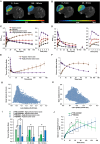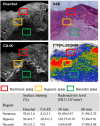18 F-Fluorination of Nitroimidazolyl-Containing Sultone: A Direct Access to a Highly Hydrophilic Radiotracer for High-Performance Positron Emission Tomography Imaging of Hypoxia
- PMID: 39211595
- PMCID: PMC11350728
- DOI: 10.1021/jacsau.4c00546
18 F-Fluorination of Nitroimidazolyl-Containing Sultone: A Direct Access to a Highly Hydrophilic Radiotracer for High-Performance Positron Emission Tomography Imaging of Hypoxia
Abstract
Hypoxia, characterized by nonphysiological levels of oxygen tension, is a key phenomenon common to the majority of malignant tumors with poor prognosis. Many efforts have been made to develop hypoxia imaging for diagnosis, staging, and monitoring of diseases, as well as for evaluating therapies. PET Imaging using 18F-fluoronitroimidazoles (i.e., [18F]FMISO as a lead radiotracer) has demonstrated potential for clinical investigations, but the poor contrast and prolonged acquisition times (>2.5 h) strongly limit its accuracy and routine developments. Here, we report an original [18F]fluoronitroimidazole bearing a sulfo group ([18F]FLUSONIM) that displays highly hydrophilic properties and rapid clearance, providing high-performance hypoxia specific PET imaging. We describe the synthesis and radiosynthesis of [18F]FLUSONIM, its in vivo preclinical evaluation by PET imaging in healthy rats and a rhabdomyosarcoma rat model, as well as its radiometabolization and histological studies. [18F]FLUSONIM was prepared in a single step by high yielding radiofluorination of a sultone precursor, highlighting the advantages of this new radiolabeling approach not yet explored for radiopharmaceutical development. PET imaging experiments were conducted by systematically comparing [18F]FLUSONIM to [18F]FMISO as a reference. The overall results unequivocally demonstrate that the developed radiopharmaceutical meets the criteria of an ideal candidate for hypoxia PET imaging-rapid and efficient radiosynthesis, total stability, exclusive urinary elimination, high specificity for hypoxic regions, unprecedented tumor/background ratios, short acquisition delays (<60 min), and promising potential for further preclinical and clinical applications.
© 2024 The Authors. Published by American Chemical Society.
Conflict of interest statement
The authors declare no competing financial interest.
Figures







References
-
- Bigos K. J.; Quiles C. G.; Lunj S.; Smith D. J.; Krause M.; Troost E. G.; West C. M.; Hoskin P.; Choudhury A. Tumour response to hypoxia: understanding the hypoxic tumour microenvironment to improve treatment outcome in solid tumours. Front. Oncol. 2024, 14, 1331355.10.3389/fonc.2024.1331355. - DOI - PMC - PubMed
LinkOut - more resources
Full Text Sources
